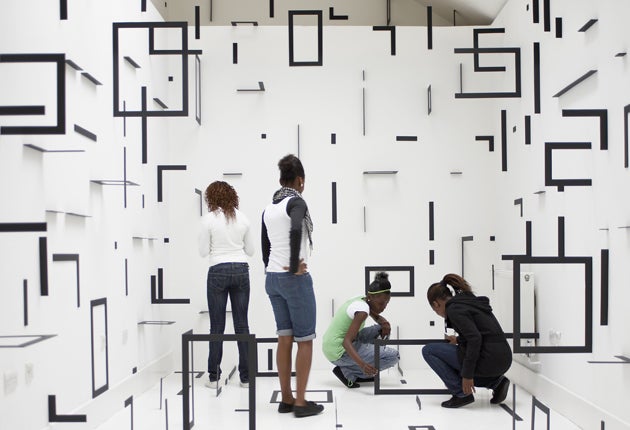Beyond These Walls, South London Gallery, London
An exhibition close to a burnt-out south London estate looks long and hard at the gulf between 'us' and 'them'

Your support helps us to tell the story
From reproductive rights to climate change to Big Tech, The Independent is on the ground when the story is developing. Whether it's investigating the financials of Elon Musk's pro-Trump PAC or producing our latest documentary, 'The A Word', which shines a light on the American women fighting for reproductive rights, we know how important it is to parse out the facts from the messaging.
At such a critical moment in US history, we need reporters on the ground. Your donation allows us to keep sending journalists to speak to both sides of the story.
The Independent is trusted by Americans across the entire political spectrum. And unlike many other quality news outlets, we choose not to lock Americans out of our reporting and analysis with paywalls. We believe quality journalism should be available to everyone, paid for by those who can afford it.
Your support makes all the difference.On the afternoon of Friday 3 July, a fire broke out at Lakanal House on the Sceaux Gardens Estate in Camberwell. Within minutes, six people were dead, among them three children.
What is this sad story doing in an art review? Three weeks later, on Friday 24 July, an exhibition called Beyond These Walls opened at the South London Gallery, in the shadow of Lakanal House. Among works in the show is an installation by a thirtysomething Danish environmental artist called Tue Greenfort, best known for driving around in a plant oil-powered bus. Roughly speaking, the aim of Beyond These Walls is to re-examine the SLG's place in its locale, a piece of introspection brought about by the gallery's current expansion. Greenfort takes the show's title literally, his work consisting of punching a hole through the chain-link fence that separates the SLG from Sceaux Gardens and leaving the back door open. From inside this Victorian temple of art, you can now see the sub-Mies mess of Lakanal House.
Greenfort's intervention sounds less simple than simplistic: what more unsubtle way could there be of exploring a boundary than by snipping through it with wire cutters? And yet his work is oddly troubling.
For one thing, the new back way into the South London Gallery is, strictly speaking, not new at all. Greenfort's installation re-creates the original entrance to the SLG, closed off when Sceaux Gardens was built in 1960. Far from embracing Camberwell, the Dane's vandalised fence suggests the gap that has grown up between it and the gallery over the past 100 years. Rough-edged, the hole also feels illicit – the first thing you see as you walk through it is a sign on the SLG's back wall warning of burglar-proof paint. All this was brought into sharp focus by the fire at Lakanal House. In deference to local feeling, a plan to funnel visitors into the gallery via Sceaux Gardens had to be shelved. Despite Greenfort's hole, the divide between the us of contemporary art and the them of a council estate remains as sharp as ever.
It takes courage for an artist to say this kind of thing, but then Greenfort has never been short of that. Part of the point of his allegedly green bus is that it is actually hardly less polluting than the petrol-driven kind: a bumper sticker on it reads "Drive on plant oil, destroy the planet." The world, in Greenfort's view, is not an easy place to save; in fact, it may not be saveable at all.
If making this kind of work takes guts, then even more so does showing it. The simplest thing for the SLG to have done with Beyond These Walls would have been to commission work that spun the truth – icky, smiley things, oozing social inclusion and New Labour accessibility. Instead, and with typical rigour, the gallery has gone for the difficult route, allowing itself to be picked apart and the bits to be examined.
This is most literally true of a young Belgian called Leon Vranken. (None of the six foreign artists in the show knows much of London, thus coming to SE5 with a fresh eye.) If Greenfort exhumes the SLG's original entrance, then Vranken does the same with its floor. Entombed beneath the present wooden structure is a piece of High Victorian marquetry by Walter Crane, adorned with the legend "The source of art is in the life of a people". Vranken has sawed a cluster of neo-geo shapes out of the modern flooring, thus promising (misleadingly, as it turns out) a glimpse of Crane's original. He has then used the resulting off-cuts of wood to build a chair and a shelf.
Seen in the grandeur of the SLG's main gallery, Vranken's termite holes and rickety furniture seem pitiable, a pale shadow of that grand Victorian experiment in social engineering trumpeted by Crane's motto. At the same time, the shelf and chair, meagre and unheroic, do at least feel human. Through the South London Gallery's back door, left open by Greenfort, you can see the results of a later social experiment – the rip-off Modernist blocks of the Sceaux Gardens Estate, the shoddiness of their materials obvious even from here. What they have in common with Crane is a belief in the power of power, in the bigness of the big statement. By contrast, all the work in this show – Esther Stocker's foamboard Bridget Riley, Ayse Erkmen's hand-painted text on builders' helmets – speak modestly and in a quiet voice. As a result, like Beyond These Walls – like the South London Gallery itself – they also speak with force.
'Beyond These Walls', South London Gallery, London SE5 (020-7703 6120) to 20 Sep
Join our commenting forum
Join thought-provoking conversations, follow other Independent readers and see their replies
Comments